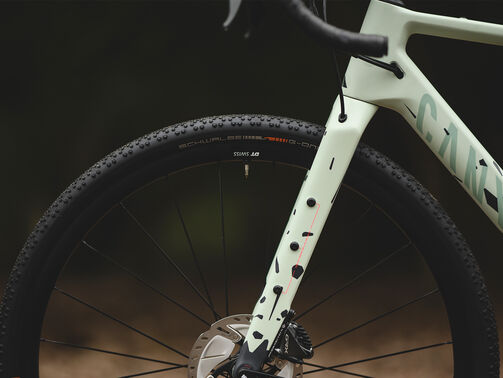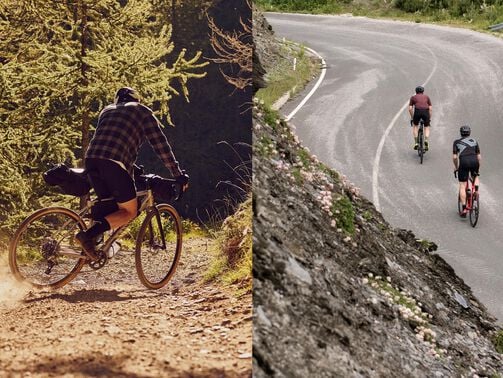Gravel bike vs hybrid: Differences and similarities
When it comes to gravel bike vs hybrid bike, how do they measure up and which is right for you? We take a look at what sets these two bike categories apart.


Similar tyres, rigid frames and space for accessories. Is a gravel bike just a hybrid but with twisty handlebars?
While gravel bikes and hybrids do share some features, there’s more that separates these two bikes than meets the eye.
From core differences in riding philosophy to geometries that deliver a completely different feel, let’s break down the differences and similarities between a gravel bike vs hybrid bike.
Contents
The purpose behind the bike types
Gravel and hybrid bikes originated from the desire to create bikes that could handle a variety of terrains. While both incorporated features from road and mountain bikes, they were developed with different end uses in mind:
A gravel bike is primarily about unlocking the potential for fun and performance. Known for their versatility, gravel bikes excel on gravel or dirt roads and are much more oriented to long-distance, off-road exploration.
Hybrid bikes, on the other hand, are more practical everyday bikes. They provide comfort and efficiency over short to moderate distances on paved roads, bike paths and light gravel trails.
Key differences between gravel vs hybrid bikes
For cyclists seeking the right companion for their adventures, the choice of hybrid bike vs gravel bike largely hinges on geometry and handlebars:
- Geometry - Gravel bikes have a more aggressive, less upright posture, allowing the rider to activate more muscle groups in their legs, be more aerodynamic, go faster and go for longer. Frames for gravel bikes come in two material options, aluminium and carbon. Aluminium is more durable, and carbon is prized for its lightness and vibration-dampening properties. Hybrid bikes, emphasising comfort over efficiency and speed, adopt a more conservative geometry. This design choice leads to a more upright riding position, which not only enhances comfort but also improves visibility for the rider in traffic conditions.
- Handlebars - Like road bikes, gravel bikes typically come with drop handlebars. This design offers multiple hand positions, allowing riders to change their posture and distribute pressure on longer rides. The straight bars—or flat bars—on a hybrid bike prioritise comfort and ease of use. This type of handlebar caters to riders looking for a relaxed ride in urban environments or on gentle off-road paths.
Terrain is another differentiating factor, with gravel bikes much better equipped to go off-road than hybrid bikes. (If you’re looking to get further off the beaten path, you can see how mountain bikes and hybrid bikes stack up or how gravel bikes compare to mountain bikes).
To sum it up, hybrid bikes are popular with commuters and cycle couriers, and a big plus is their simplicity. In contrast, gravel bikes are all-terrain companions with adventure-ready features ideal for longer, off-road rides.
Hybrid vs gravel bike geometry
Designed to handle everything from cobble roads to the dirt far beyond the beaten path, the geometry of a gravel bike is more performance-oriented but blends stability, comfort and versatility:
- A longer wheelbase gives gravel bikes improved control and stability across uneven terrain.
- A slacker head tube angle makes for more stable, responsive and confident handling—useful when descending steep trails or navigating technical sections.
- A higher stack height supports a more upright riding posture than the more aggressive, leaned-forward position on road bikes. This minimises fatigue on the rider's back on long rides.
Design differences within the gravel category depend on philosophy. Certain gravel models, such as the Canyon Grail, are more high-performance/race-oriented, while others, like the Pathlite range, cater to leisure riding and touring.
Hybrid bikes are fine-tuned for comfort, ease of use and practicality. Their geometry is designed to create a balanced, approachable riding experience:
- Hybrid bike geometry puts the rider in a more upright position. An upright posture is beneficial for visibility and comfort when riding in the city.
- Hybrid bikes feature a wheelbase that strikes a balance between manoeuvrability for city navigation and stability for light off-road use.
- Hybrids have a longer tube top to match the flat handlebars and are usually slacker than a road bike.
- The frame design prioritises pedalling comfort, with less consideration for performance riding elements like aerodynamics and steering agility.
The geometry difference between a hybrid and a gravel bike can't be overstated. The design differences underpin the gravel bike's agility on mixed terrains and the hybrid bike's comfort and handling on city streets.

Drop bar vs flat bar comparison
Drop bars are the most common handlebars used on gravel bikes. They bring the rider’s head down towards the stem, lowering the centre of gravity for a more aerodynamic riding position.
Drop bars have a few advantages that contribute to the performance of gravel bikes:
- Multiple hand positions: Long rides are why drop bars exist. Riders can switch hand positions to hold the tops, hoods or drops, which allows for changes in posture and grip over long rides, helping to reduce fatigue and strain.
- Aerodynamic Position: Holding the drops puts the rider in a more aerodynamic position, lowering wind resistance and enabling higher speeds.
- Control on Descents: The lower grip position on the drops offers improved control and stability when descending at high speeds.
- Leverage for Climbing: The wider grip on the drops can also provide more leverage when climbing, making it easier to apply force to the pedals on steep inclines.
The flat bar handlebars of hybrid bikes are wider and straighter compared to the curved drop bars, giving the rider more stability and control on busy streets, as well as other benefits:
- More visibility: The upright position afforded by flat bars helps improve the rider’s view of the road and surroundings, which is helpful for urban riding.
- Ease of Use: Flat bars are straightforward and user-friendly, making them a popular choice for beginner cyclists and those who prefer simplicity and comfort over speed.
- Stability: The wider stance on a flat bar gives riders more control when carrying loads in panniers.
Drop handlebars align with the needs of riders who value speed, efficiency and the ability to tackle a variety of terrains and riding conditions. Flat bars ensure easy handling and a relaxed arm position for more comfort.
Suspension components
Typically, gravel bikes don't include suspension systems. They're designed with rigid frames to keep the balance between being lightweight and efficient, which is crucial for handling mixed terrains over long distances. Instead of suspension, gravel bikes use wider tyres at lower air pressures to cushion vibrations and impacts.
Likewise, many hybrid bikes also skip the suspension since they're mainly intended for smoother, urban terrains rather than rugged off-road paths. Since suspension forks add weight and reduce pedalling efficiency, riders often prefer bikes without them for a lighter, more responsive ride.
Wheels and tyres
Hybrid bike tyres are usually narrower and slicker compared to those on a gravel bike, designed for 700c wheels typical of road bikes and measuring about 28-32mm in width. These tyres are built to last, making them well-suited for the demands of city commuting, although they're not as focused on performance as gravel bike tyres.
Tyres found on gravel bikes are wider to create stability and grip. Gravel bike wheels are 700c in diameter (some use smaller 650b wheels) and have greater tyre clearance of 40-45mm and up to 50mm in 700c on more robust models, as seen on the Canyon Grizl. Wider tyres mean more traction on loose surfaces and better grip on light mud.

Brake mechanisms
The braking system is crucial on any bike, but particularly for hybrid bikes where navigating through traffic demands reliable stopping power.
Hybrid bikes can come with two types of brake systems:
- Rim brakes with pads that grip onto the wheel rim to stop it from moving forward.
- Disc brakes with brake pads that grip onto a brake rotor mounted to the wheel hub. They can be hydraulic, which self-adjusts for brake pad wear, or mechanical, which needs manual adjusting as the pads wear.
Most hybrid bikes are now equipped with disc brakes, offering stronger and more reliable stopping power in various conditions than the older rim brakes. Gravel bikes almost exclusively use disc breaks. Disc brakes are the most efficient and safest way to reduce speed when riding off-road.
Gearing systems
The gearing system on a hybrid bike is all about efficiency. The 2x drivetrain gives the rider more gear options while riding at slower speeds, making it easier to pedal. Whether on a long incline or pedalling into a headwind, more gear options mean smaller steps and a higher likelihood of finding the ideal ratio.
Gravel riders need to handle tricky terrain and loose surfaces and gravel bikes typically offer much wider gear ranges than road bikes. Most gravel bikes run 1x setups (single front chainring). This system is designed for added flexibility to accommodate high-speed flat sections and steep climbs. Find out more about gravel groupsets in this article.
Racks and mudguards
As hybrid bikes are frequently used for commuting and urban riding, having the capacity to carry groceries or work essentials is ideal. As such, most hybrid bikes come with mounting points for pannier racks.
Mudguards on hybrid bikes tend to be wider to offer maximum protection against road spray, mud and water. Wider mudguards are especially useful in urban areas when riding through puddles and wet roads, keeping the rider drier and the bike cleaner.
Adventure-ready gravel bikes have plenty of options for attaching racks, fenders and other gear for bikepacking or off-road excursions. The racks used are often minimalist in design, aimed at carrying gear for longer, self-supported rides rather than everyday urban cargo.
Gravel bike vs hybrid: How to make the right choice?
First, consider what you want to accomplish by riding. While hybrids share many features of a gravel bike, speed and distance are not their strong suit. A hybrid will cope on recreational rides, but you'll likely find it doesn't let you push yourself as much exercise-wise.
If you’re deciding between a gravel bike vs hybrid for commuting, a hybrid bike is a great, practical companion for city rides. It’s typically easier to fit panniers, and the more upright posture makes you more visible to drivers in traffic (you may also want to consider a city bike, and you can read about the differences between a hybrid and city bike in this article).
For long rides, a gravel bike is the go-to option. The geometry is more sporty, and drop handlebars provide different hand positions to increase comfort (new riders may find drop handles take some getting used to at first). Gravel bikes are also known for their versatility. They’re a go-anywhere ride. If you want to take on dirt, explore trails and go on longer off-road adventures, a gravel bike is the right choice.
As you weigh your options between a gravel and a hybrid bike, you might also want to consider the emerging category of all-road bikes for an even broader exploration of what’s possible on two wheels.
Discover our Gravel Bikes
Did this article help?
Thank you for your feedback








